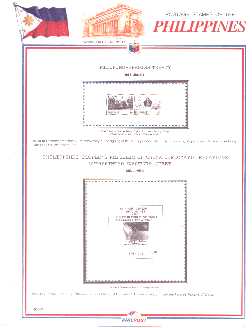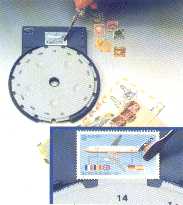Philatelic Jargon
Dateline: 11/15/99 | Source: The Philippine Hobbyist Magazine
A model maker needs a screwdriver and glue, a cross-stitcher her needles and cloth, crocheter her yarns and hook, photographer his chemical and negatives, as we say: to each his own. Like all hobbies, philately employs its own tools.

|
STAMP ALBUM. A stamp album is different from your ordinary photo album, but some collector claim the latter would suffice, especially the magnetic kind. The Stamp Album, those sold commercially, is but an improvement of the photo album version and contains a replica of the stamp/s and side notes. The notes included could be a simple date of issuance and when applicable the country of origin, or an elaborate one adding an exposition regarding the vignette [central design], the denomination, printing details which includes the printer, the designer, the method and the number of stamps issued per denomination. More often than not, the description of the vignette entails the history of the significant event being commemorated, a short biography of the person depicted or simply an explanation of the components.
|
Blank album pages are also available on the market giving the collector or philatelist the freedom to arrange the stamps and annotate them as they please. A stock album, on the other hand, is but a repository of loose stamps prior to their transfer to the stamp album. These albums are comprised of pages with panels of transparencies serving as sleeves or holders.
Remember the adage: A small collection is lost in the big album. Thus, it is better to have a loose-leaf album that offer a means of keeping the collection compact and adding page by page as required rather than getting the thickest stamp album and finding that your collection can't fill them all.
PhilPost subscribes to this adage, thus its Official Album Pages offers a non-distracting border and ornamentation, a replica of the vignette with a short description arrange chronologically. Internationally, the
Scott,
KABE,
Minkus, are but a few producers of stamp albums.
|
CATALOG. The other most important tool of philately is the stamp catalog. A catalog lists almost all the issued stamp of a country, a topic or a theme. Most catalogs in existence are on the first type, especially those published by
Scott,
Michel,
Minkus and
Stanley Gibbons.
For Philippine collections,
Peter W.A. Harradine published in 1977 a three-section handbook divided into 1) Spanish period [1854-1899], 2) American period, [1899-1946], inclusive of the Japanese occupation period, [1940-1945], and 3) Republican period, [1946-1977].
Abraham Q. Luspo, Jr. released the Philippine Postal Catalogue, Republic Period, 1946-1990 in 1991. The Stamp Shop published
Dr. Ngo Tiong Tak T.'s Catalogue of Philippine Republic Stamps & Postal Stationeries [1946-1997] in 1997. Dr. Ngo recently issued supplements for the year 1998 and 1999. A list of specialized stamp catalogs and books can be found on the World Wide Web at
Stamps.Org. An online
Philippine Stamp Catalog by this author can be verified at
http://www.geocities.com/abda/
|


|
|
MOUNTS. Mounts are simple devices that secure the stamps in an album. Although there are hingeless albums employing vinyl stock pages, most commercially produced albums either need hinges or mounts. Mounts are preferred to hinges because the latter could damage the stamps in the long run especially when improperly used. Mounts are composed of a film or transparency backed with black matting. Hinges, on the other hand, are thin, transparent, gummed paper strips.
|

|

|
TONGS. Tweezers are simple but important accessory. These are used to handle the stamps during sorting and mounting. The cardinal rule is that: do not handle the stamps manually for natural oil from human hands could damage the color and condition of mint or even used stamps.
|
|
ACCESSORIES. Binders, watermark detectors, perforation gauge, stamp dryer and magnifying glass are useful additions as you progress in stamp collecting.
Binders and slipcases protect the album pages from damage. A
watermark detector effectively reveals the watermark of postage stamp without the use of any chemical aids, inflammable liquids or ink pads. It would also reveal thins, grills, repairs, hinge marks, added margins, silk threads, granite paper, and paper irregularities. Previously, a drop of benzine and a black surface were employed to view the watermark.
|

|

|
Perforation Gauge can be a printed chart or scale on plastic or paper or a wheel of plastic moulding with graduated series of dots and lines in a column two centimeters wide used in measuring perforations. The gauge is reckoned in terms of the number of holes or punches. Most catalogs denote what the perforation number is, but a gauge could compare the catalogued number with that of the stamp in your possession.
|
|
Stamp dryer comes with blotting paper used in separating the stamps from the cover or letter envelopes. For majority of stamps, the dryer is used after a bath treatment, although a humidifier is used for stamps where a risk of colors being soluble in water is known. Peroxide of hydrogen in solution is useful for restoring the stamp color due to exposure or desulphuration.
|

|
|
Magnifiers are used for the careful study of stamp conditions invisible to the naked eye. The most common types used are 1) Reading Magnifier 2) Precision Glass and 3) Folding Stand Magnifier.
|
Happy philately!
Previous Features:
1997 :
1998
|